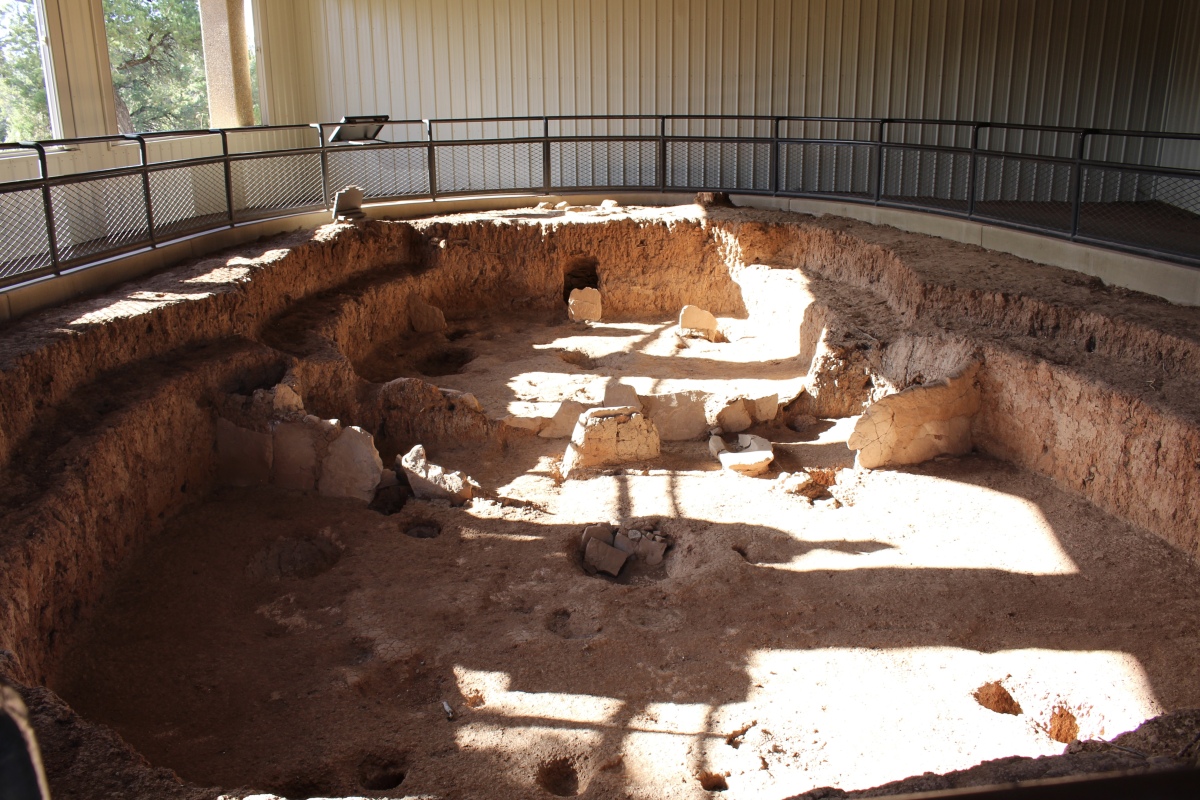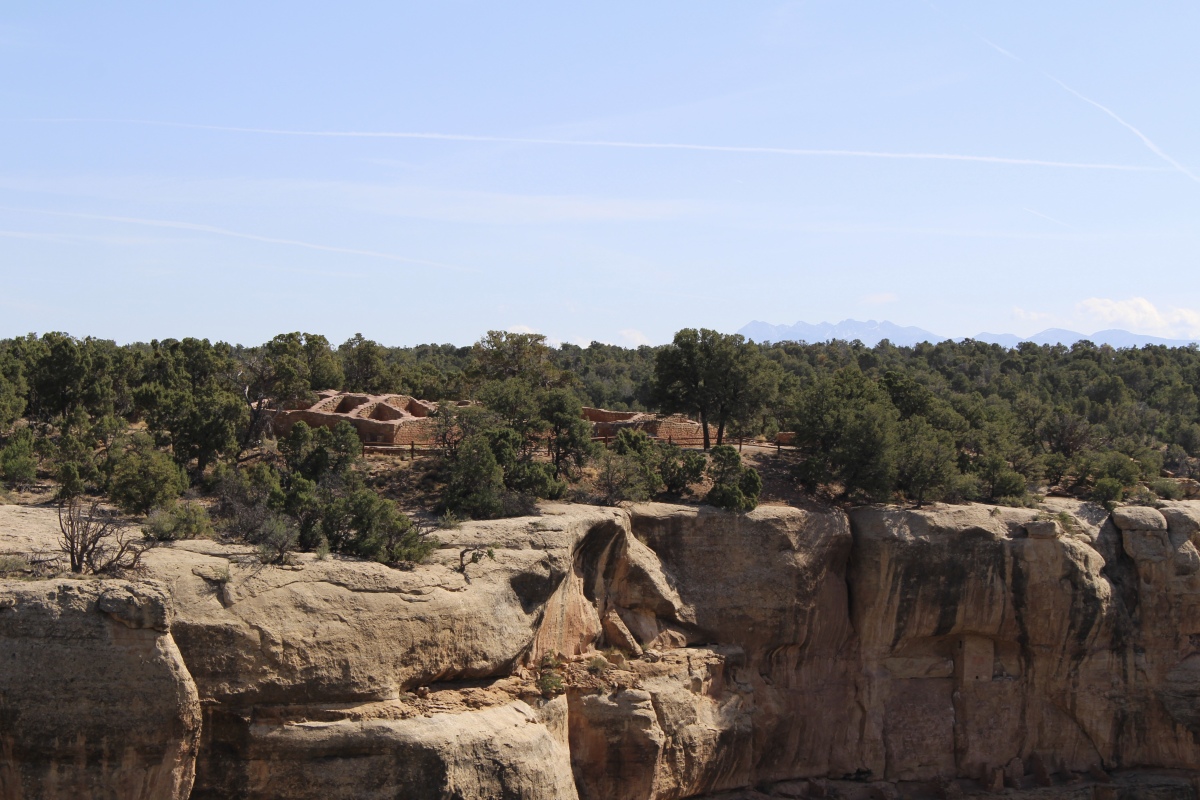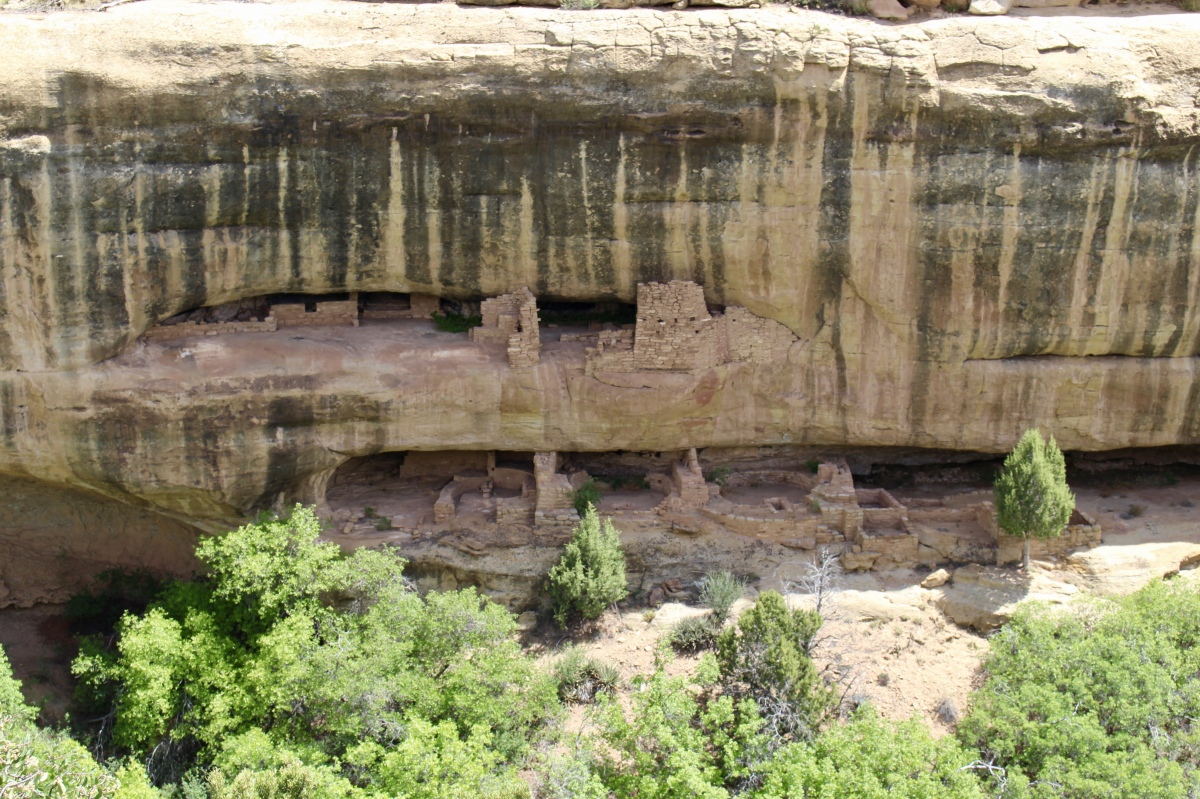Holly was our guide for the Aramak tour at Mesa Verde National Park from 8-12 a.m. Monday morning. The tour only covered Chapin Mesa. We headed straight for the Mesa Top Loop while she told us some of the history of Mesa Verde, which became a National Park in 1906. It became the first World Heritage Site in the U.S. in 1978. The park is not known for its beauty, she said, but for its cultural heritage, with the ancestral homes of 21 modern-day Pueblo groups that trace their ancestry back to these regions. Thus the park preserves a link from the past to the present.

Aramak tour
The flute player clan of the Hopi tribe says they came from Mesa Verde. It is surmised that people left because of overpopulation, drought, or stress on the society. Or it is also likely that this just wasn’t a good place to live anymore.
At the top of Chapin Mesa, we see burnt out skeletons of trees; Holly tells us a wildfire caused by lightning burnt 2,800 acres in 2002.
Our first stop was at the Pithouses and Pueblos (A.D. 700-950). The pitroom was used for ceremonies as well as cooking and sleeping. A hole in the roof allowed smoke to escape the pithouse. However, breathing may have still been difficult in these smoky, subterranean rooms.
Villages of this era had only one or two pitrooms. The slabs and floor cavities are typical of earlier pithouses; some villagers may have moved here in winter, finding the pitroom easier to heat than surface dwellings.

Pithouses

Pithouses
Holly told us about the vegetation on the mesa. She said the Utah junipers were infested by mistletoe, a parasite that kills the junipers. Juniper is absorbent and is used for bandages, diapers and John Wayne toilet paper, the packaging of which says “It’s rough! It’s tough! And it doesn’t take crap off anyone!” Juniper berries flavor gin and game meat, and are used to make ghost beads to protect people from bad dreams.
The pinyon pines have a sticky sap used for sealant. They were used to seal baskets used for carrying water and for healing cream. Needles are used to make tea. Pine nuts from pinyon pines are expensive because they only come out every 4-7 years.
According to Holly, the broad leaf yucca is not a succulent. The fibers were used as paintbrushes to decorate pottery and pre-threaded sewing needles. They were weaved to make sandals and plaited together to make rope and baskets. The root could be used as soap.
The Gamble Oaks in the canyon are only ten feet tall. There are no cottonwoods in the canyon because they need more water than is available.
We saw an Anasazi kiva, or underground religious room. The small, circular hole in the floor is a sipapu, a symbolic entrance into the underworld – the Pueblo place of origin. The kiva had several functions: crafts workshop, social gathering place, and a chamber in which to plan or perform ceremonies.

Ceremonial chamber

Ceremonial chamber
We stood in the courtyard of an early pueblo village. By 850 A.D., most Mesa Verde people were living in surface dwellings instead of pithouses. Adjoining rooms may reflect a greater degree of cooperation required by an expanding population.
The walls were built by setting poles upright and weaving small sticks between them, then plastering the walls with mud – a technique called “wattle and daub.”
Three distinct villages are here; for at least 150 years, a succession of Pueblo farmers occupied this same plot of ground. The mesa top was not the ideal place to live as it had poor drainage and was exposed to harsh weather, with earthen rooms chilled over the winter by deep snow.

village at Mesa Verde
We saw a view of Navajo Canyon from the bus, but we didn’t get off.

Navajo Canyon view
We stopped at views for Cliff Canyon, Oak Tree House Cliff Dwelling, Fire Temple, Sun Temple and Cliff Palace. The cliff dwellings themselves were not built until the final 75-100 years of Mesa Verde’s occupation. For over 600 years, the people lived mostly on the mesa tops.

Cliff Canyon

Oak Tree House Cliff Dwelling

Oak Tree House Cliff Dwelling

Sun Temple atop the canyon

Fire Temple

Fire Temple

Fire Temple
Sadly, I was unable to visit Cliff Palace because it was closed until the following weekend. We were only able to view it from the overlook on the opposite side of the canyon.

Cliff Palace
We visited Sun Temple with its bread loaf stones. From above, the D-shaped symmetry of the temple is remarkable, especially its twin kivas. Such massive construction must have involved a community-wide effort. The structure was never completed; there is no evidence of a roof or roof timbers. Apparently construction stopped when the Anasazi people began to leave the area. Though the structure appears ceremonial, its exact function remains a mystery.
The natives here used hand and toe holds to carry corn in baskets from farms on the mesa top to the cliff dwellings. There was no evidence of death from falls. Residents here adapted to the environment.
At the end of our tour, we stopped for one final view of Cliff Palace, the largest of Mesa Verde’s cliff dwellings.

Cliff Palace

me with Cliff Palace in the background
Here are my other Mesa Verde posts:
mesa verde overlooks
the step house trail at mesa verde
balcony house at mesa verde
*Monday, May 21, 2018*
*********************
“PHOTOGRAPHY” INVITATION: I invite you to create a photography intention and then create a blog post for a place you have visited. Alternately, you can post a thematic post about a place, photos of whatever you discovered that set your heart afire. You can also do a thematic post of something you have found throughout all your travels: churches, doors, people reading, people hiking, mountains, patterns, all black & white, whatever!
You probably have your own ideas about this, but in case you’d like some ideas, you can visit my page: photography inspiration.
I challenge you to post no more than 20-25 photos and to write less than 1,500 words about any travel-related photography intention you set for yourself. Include the link in the comments below by Wednesday, July 3 at 1:00 p.m. EST. When I write my post in response to this challenge on Thursday, July 4, I’ll include your links in that post.
This will be an ongoing invitation, every first, second, and third (& 5th, if there is one) Thursday of each month (I’ve now added the second Thursday). Feel free to jump in at any time. 🙂
I hope you’ll join in our community. I look forward to reading your posts!
the ~ wander.essence ~ community
I invite you all to settle in and read a few posts from our wandering community. I promise, you’ll be inspired!
- Jude, of life at the edge, captured some gorgeous sculptures in a serene and inviting setting at Barbara Hepworth Sculpture Garden in St. Ives.
Thanks to all of you who shared posts on the “photography” invitation. 🙂






How incredibly resourceful these people were, Cathy. Everything in nature got used, whereas now it’s all synthetics. We are trying to turn back that tide, but necessity was obviously a great motivator. The cliff houses have such wonderful outlooks, but maybe sparse on home comforts 🙂 🙂
LikeLike
I am always impressed when I read about how resourceful people were back when they had to figure out how to scrape out a living off the land. I always wonder how they figured out the uses for all these plants? I guess it was by experimentation, and trying and failing many times. It was impressive. I don’t know if there were many comforts in these places, but it’s hard to tell with what’s remaining. 🙂
LikeLiked by 1 person
Thanks for this post. I need to go visit there soon. It looks like an amazing place with tons of history!
LikeLike
Thanks for reading Lenore. I hope you can make it to Mesa Verde. It really is an amazing park. 🙂
LikeLike
good one…thanks for share
LikeLike
Thanks for dropping by! 🙂
LikeLike
Reminds me of “Ill Wind”, a mystery by Nevada Barr, that is located in the Mesa Verde NP. Am glad I can now see some of the places mentioned in the book.
LikeLike
Thanks for telling me about that book, Pit. I’m not normally a reader of mysteries, so I’ll have to check it out. 🙂
LikeLiked by 1 person
I can’t really tell why, but I have liked others by the same author better.
LikeLike
Good to know, Pit. I’ll have to keep that in mind when I read her books. 🙂
LikeLiked by 1 person
These homes are so well preserved and it’s great that we can learn about them. I always find it interesting how plants were used in the past, and wonder why we don’t still do this.
LikeLike
These cliff dwellings and pit houses are very well preserved thanks to the National Park Service. I always wonder about whether people use those plants today, maybe on a larger scale. 🙂
LikeLiked by 1 person
enjoyed reading your post. Sharing mine for the ‘photography invitation
http://travtrails.com/2019/06/22/toronto-summer-bluffing-away-3/
LikeLike
Thanks, Indra. And thanks for joining in my invitation and sharing your beautiful photos of these bluffs along Lake Ontario. I’ll link this to my post on July 4. 🙂
LikeLiked by 1 person
Having named my rescue dog Juniper, I quite enjoyed the passage about its uses. Haha! I find the fragrance of Juniper and Pinyon Pines intoxicating. Scent memory can be strong, as such we have a stockpile of “Incense of the West” that, when burned, gives us just little taste of our beloved high desert.
I’m usually not into bus tours, but this one looks great. I’m sorry you missed visiting Cliff Palace. It’s an interesting tour. I wish that the park would reopen Spruce House to visitors, however I don’t think that will ever happen due to safety issues.
LikeLike
I fell in love with the smells of juniper and pinyon pines while I was in the Four Corners, Marsi. What a wonderful name for your rescue dog! What a great thing to do, burning your “incense of the West” to bring back scent memory.
I was just a bit too early for Cliff Palace, but I did do Balcony House, which was quite interesting. The tour was good; I’m not usually a fan of tours but I was on my own so thought I’d give it a try. It is too bad about Spruce House. Mesa Verde is a fantastic park, isn’t it?
LikeLiked by 1 person